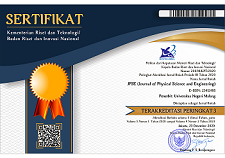Implementation of Line of Sight Algorithm Design Using Quadcopter on Square Tracking
Abstract
The improvement of the quadcopter has extended its function, even for risky army tasks, i.e., search, reconnaissance, and rescue operations. The quadcopter also can be implemented for medical tasks, such as mapping wind velocity conditions, detecting radiation sources, surveillance, and upkeep and surveys. A quadcopter is a non-linear machine with more than one enter and output and a machine with balance problems. It is simply prone to outside disturbance. This function reasons a few problems in controlling the monitoring motion and adjusting the dealing with the path automatically. Based on those problems, this looks like the monitoring manipulated layout within the horizontal place with the aid of including the line of sight's set of rules. So, that direction following converges closer to 0 and may conquer the disturbance of ocean currents that extrude the parameters of the quadcopter in shifting at the horizontal place. The controller benefit is acquired using the numerical iterative of the Linear Matrix Inequality (LMI) technique. Meanwhile, Command-Generator Tracker (CGT) controls the monitoring function at the x and y. The simulation effects display that the manipulation technique can deliver the yaw, pitch, and roll to the anticipated values on a rectangular track.
Keywords
Full Text:
PDFReferences
T. Luukkonen, (Aug. 2011). Modelling and control of quadcopter [Online]. Available: https://www.researchgate.net/file.PostFileLoader.html?id=576d16ed93553b24b5721a9a&assetKey=AS%3A376462596165634%401466767085787.
V. Praveen and S. Pillai, “Modeling and simulation of quadcopter using PID controller,” Int. J. Control Theory Appl., vol. 9, no. 15, pp. 7151–7158, 2016.
A. Nemati and M. Kumar, “Modeling and control of a single axis tilting quadcopter,” in 2014 American Control Conf., Portland, OR, USA, Jun. 2014, pp. 3077–3082, doi: 10.1109/ACC.2014.6859328.
A. V. Javir, K. Pawar, S. Dhudum, N. Patale, and S. Patil, “Design, analysis and fabrication of quadcopter,” J. Adv. Res. Mech. Civ. Eng., vol. 2, no. 3, pp. 15–23, Mar. 2015, doi: 10.53555/nnmce.v2i3.342.
A. T. Nugraha, “Desain kontrol path following quadcopter dengan algoritma line of sight,” in Pros. SENIATI, vol. 3, no. 1, Feb. 2017, p. B9. 1–8, doi: 10.36040/seniati.v3i1.1620.
N. Intaratep, W. N. Alexander, W. J. Devenport, S. M. Grace, and A. Dropkin, “Experimental study of quadcopter acoustics and performance at static thrust conditions” in 22nd AIAA/CEAS Aeroacoustics Conf., Lyon, France, May 2016, p. 2873, doi: 10.2514/6.2016-2873.
N. Xuan-Mung and S. K. Hong, “Improved altitude control algorithm for quadcopter unmanned aerial vehicles” Appl. Sci., vol. 9, no. 10, p. 2122, May 2019, doi: 10.3390/app9102122.
A. T. Nugraha, “Desain kontrol path following quadcopter dengan command generator tracker model following,” M.Si. Thesis, Dept. Elect. Eng., Institut Teknologi Sepuluh Nopember, Surabaya, Indonesia, 2017. [Online]. Available: https://core.ac.uk/download/pdf/291462939.pdf.
U. Seljak and M. Zaldarriaga, “A line of sight approach to cosmic microwave background anisotropies,” Astrophys. J., vol. 469, no. 437–444, Mar. 1996, doi: 10.48550/arXiv.astro-ph/9603033.
T. I. Fossen, M. Breivik, and R. Skjetne, “Line-of-sight path following of underactuated marine craft,” in IFAC Proc. Vol., vol. 36, no. 21, Sep. 2003, pp. 211–216, doi: 10.1016/S1474-6670(17)37809-6.
W. Zhou et al., “Event-triggered approximate optimal path-following control for unmanned surface vehicles with state constraints,” IEEE Trans. Neural Netw. Learn. Syst., pp. 1–15, Jul. 2021, doi: 10.1109/TNNLS.2021.3090054.
W. R. Boswell, J. B. Bingham, and A. J. Colvin, “Aligning employees through “line of sight”,” Bus. Horiz., vol. 49, no. 6, pp. 499–509, Dec. 2006, doi: 10.1016/j.bushor.2006.05.001.
A. T. Nugraha, “Disturbance rejection berbasis los saat tracking pada jalur lingkaran menggunakan quadcopter,” in Pros. SENIATI, vol. 4, no. 1, Feb. 2018, pp. 50–56, doi: 10.36040/seniati.v4i1.313.
W. R. Boswell and J. W. Boudreau, “How leading companies create, measure and achieve strategic results through “line of sight”,” Manag. Decis., vol. 39, no. 10, pp. 851–860, Dec. 2001, doi: 10.1108/EUM0000000006525.
K. H. Khalil, “Adaptive output feedback control of nonlinear systems represented by input-output models,” IEEE Trans. Autom. Control, vol. 41, no. 2, pp. 177–188, Feb. 1996, doi: 10.1109/9.481517.
L. Liu, A. Chen, and Y. J. Liu, “Adaptive fuzzy output-feedback control for switched uncertain nonlinear systems with full-state constraints,” IEEE Trans. Cybern., vol. 52, no. 8, Jan. 2021, doi: 10.1109/TCYB.2021.3050510.
A. Levant, “Higher-order sliding modes, differentiation and output-feedback control,” Int. J. Control, vol. 76, no. 9–10, pp. 924–941, 2003, doi: 10.1080/0020717031000099029.
A. J. Calise, N. Hovakimyan, and M. Idan, “Adaptive output feedback control of nonlinear systems using neural networks,” Automatica, vol. 37, no. 8, pp. 1201–1211, Aug. 2001, doi: 10.1016/S0005-1098(01)00070-X.
Y. Zhu, N. Xu, X. Chen, and W. X. Zheng, “H∞ control for continuous-time Markov jump nonlinear systems with piecewise-affine approximation,” Automatica, vol. 141, p. 110300, Jul. 2022, doi: 10.1016/j.automatica.2022.110300.
A. T. Nugraha, I. Anshory, and R. Rahim, “Effect of alpha value change on thrust quadcopter Qball-X4 stability testing using backstepping control,” IOP Conf. Ser.: Mat. Sci. Eng. vol. 434, no. 1, p. 012207, Nov. 2018, doi: 10.1088/1757-899X/434/1/012207.
A. T. Nugraha, “Design and build a distance and heart rate monitoring system on a dynamic bike integrated with power generating system,” J. Electron., Electromed. Eng., Med. Inf., vol. 4, no. 4, pp. 210 – 215, 2022, doi: 10.35882/jeeemi.v4i4.260.
Copyright (c) 2022 Anggara Trisna Nugraha, Dimas Rinaldi, Muhammad Syahid Messiah, Muhammad Jafar Shiddiq, Moch. Fadhil Ramadhan, and Fortunaviaza Habib Ainudin

This work is licensed under a Creative Commons Attribution-ShareAlike 4.0 International License.
This work is licensed under a Creative Commons Attribution-ShareAlike 4.0 International License




















